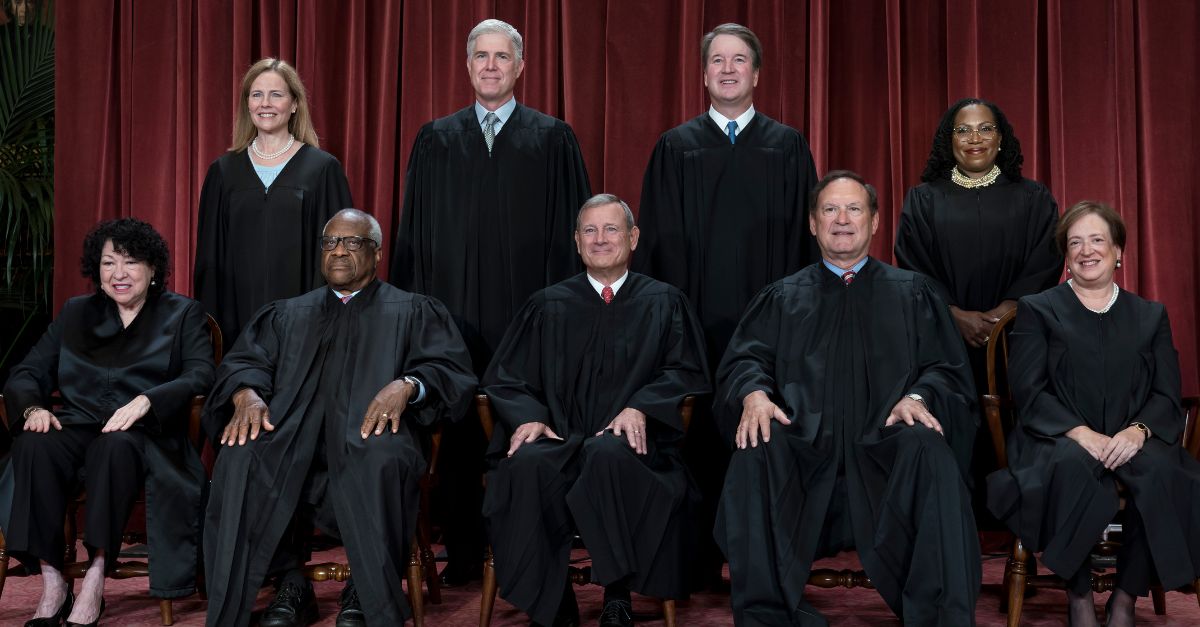
Members of the Supreme Court sit for a new group portrait following the addition of Associate Justice Ketanji Brown Jackson, at the Supreme Court building in Washington, Friday, Oct. 7, 2022. Bottom row, from left, Associate Justice Sonia Sotomayor, Associate Justice Clarence Thomas, Chief Justice of the United States John Roberts, Associate Justice Samuel Alito, and Associate Justice Elena Kagan. Top row, from left, Associate Justice Amy Coney Barrett, Associate Justice Neil Gorsuch, Associate Justice Brett Kavanaugh, and Associate Justice Ketanji Brown Jackson. (AP Photo/J. Scott Applewhite)
The Supreme Court sided unanimously with internet companies Monday in a much-anticipated decision involving Texas and Florida statutes that sought to prevent online platforms from moderating content on their sites. The statutes at issue were intended to respond to a contention that social media platforms were censoring conservative viewpoints.
The Court sent the cases Moody v. NetChoice and NetChoice v. Paxton back down to the lower courts for reconsideration.
Two tech industry trade associations, NetChoice and the Computer & Communications Industry Association, filed federal lawsuits in Texas and Florida seeking to strike down the states’ respective laws as unconstitutional violations of the First Amendment. They argued that internet companies had a First Amendment right to decide what content is prioritized or posted on their platforms and that laws prohibiting them from doing so are not only unconstitutional, but also make the internet ripe for various bad actors.
Both the U.S. Court of Appeals for the Eleventh Circuit and the U.S. Court of Appeals for the Fifth Circuit sided to some degree with the states. However, in its ruling Monday, the Supreme Court vacated the judgments of the circuit courts and found that neither the Eleventh nor the Fifth Circuit applied the proper analysis.
All nine justices agreed that the specific legal challenge at issue in the cases — a broad “facial” challenge to the laws, as contrasted with a far more specific “as-applied” challenge — required a different analytical framework than that which the lower courts employed. Facial challenges are the toughest for plaintiffs to win, because they require a finding that a law would always be unconstitutional in its application, rather than a finding that the application was unconstitutional in the context relevant to a specific plaintiff’s claim.
Justice Elena Kagan penned the unanimous ruling, while Justices Amy Coney Barrett, Ketanji Brown Jackson, Clarence Thomas, and Samuel Alito each filed concurrences.
The Court noted in its ruling that while the internet has changed dramatically in the years since its inception, the underlying question of whether a publisher can curate its own content is nothing new. Kagan said that the legal analysis demanded by the Texas and Florida statutes “must be done consistent with the First Amendment, which does not go on leave when social media are involved.”
Because the challenge to the laws was a facial challenge, the courts should have looked at the full context of the laws’ potential applications. This would have included everything from apps to emails to social media platforms. Because the lower courts failed to consider the entire scope of the laws’ application, the justices remanded the cases.
Kagan suggested, however, that an as-applied challenge would likely have shown the statutes to be unconstitutional on First Amendment grounds.
Kagan likened internet platforms to traditional publishers within the context of picking and choosing which content is displayed:
They include and exclude, organize and prioritize — and in making millions of those decisions each day, produce their own distinctive compilations of expression. And while much about social media is new, the essence of that project is something this Court has seen before. Traditional publishers and editors also select and shape other parties’ expression into their own curated speech products. And we have repeatedly held that laws curtailing their editorial choices must meet the First Amendment’s requirements.
Kagan wrote that without Texas’ law, internet platforms would be forced to display, for example, content that supports Nazi ideology; advocates for terrorism, racism, Islamaphobia, or antisemitism; glorifies rape and other violence; encourages teen suicide and self-harm; discourages the use of vaccines; advises phony treatments for diseases; and advances false claims of election fraud.
Kagan also noted that it is not the government’s job to step in and correct “bias” any time it sees fit:
But this Court has many times held, in many contexts, that it is no job for government to decide what counts as the right balance of private expression — to “un-bias” what it thinks biased, rather than to leave such judgments to speakers and their audiences. That principle works for social-media platforms as it does for others.
Kagan also took specific issue with the conservative Fifth Circuit — a court heavy with Donald Trump appointees that the Supreme Court has reversed several times recently. Kagan noted that the need to apply the correct legal framework “is especially stark for the Fifth Circuit, whose decision rested on a serious misunderstanding of First Amendment precedent and principle.”
Kagan also argued that Texas’ interest in correcting online bias would not withstand constitutional muster at any level of scrutiny.
“Texas has never been shy, and always been consistent, about its interest: The objective is to correct the mix of viewpoints that major platforms present. But a State may not interfere with private actors’ speech to advance its own vision of ideological balance.”
In Alito’s concurrence, he began with a reminder that the Court’s holding is narrow.
“NetChoice failed to prove that the Florida and Texas laws they challenged are facially unconstitutional. Everything else in the opinion of the Court is nonbinding dicta,” Alito began.
He continued, describing the purpose of the statutes as a response to concerns that “social-media platforms could abuse their enormous power.”
While he agreed with the underlying holding, Alito took serious issue with much of the majority opinion. Alito argued that internet companies’ use of algorithms is more nuanced than the majority admitted, and said the majority’s stance that the use of algorithms is “per se expressive” is at least worthy of further analysis.
You can read the Court’s full opinion here.
Have a tip we should know? [email protected]







